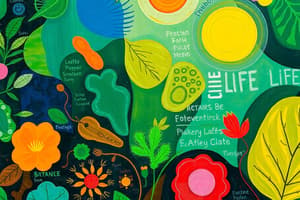Podcast
Questions and Answers
What is the first step in the scientific method?
What is the first step in the scientific method?
- Predict
- Observe (correct)
- Evaluate results
- Hypothesize
What characterizes a result that is falsifiable?
What characterizes a result that is falsifiable?
- It can be proven wrong (correct)
- It is only based on opinions
- It has empirical evidence
- It cannot be tested
Which variable changes in response to the independent variable?
Which variable changes in response to the independent variable?
- Dependent variable (correct)
- Constant variable
- Independent variable
- Extraneous variable
What is the primary purpose of a control group in an experiment?
What is the primary purpose of a control group in an experiment?
What do hypotheses lead to in the scientific method?
What do hypotheses lead to in the scientific method?
How is confidence in a hypothesis increased during scientific testing?
How is confidence in a hypothesis increased during scientific testing?
What is the next step after formulating a hypothesis?
What is the next step after formulating a hypothesis?
What is a feature of scientific theories compared to hypotheses?
What is a feature of scientific theories compared to hypotheses?
Which biomolecule is made of amino acids?
Which biomolecule is made of amino acids?
What is a primary function of lipids in living organisms?
What is a primary function of lipids in living organisms?
Which of the following is NOT a key feature of science?
Which of the following is NOT a key feature of science?
What is the primary role of nucleic acids?
What is the primary role of nucleic acids?
Which carbohydrate is known for its role in forming plant cell walls?
Which carbohydrate is known for its role in forming plant cell walls?
What is one of the six characteristics that define living organisms?
What is one of the six characteristics that define living organisms?
Which process involves the capture, storage, and use of energy in an organism?
Which process involves the capture, storage, and use of energy in an organism?
Which of the following is NOT one of the six main features of life?
Which of the following is NOT one of the six main features of life?
What is considered the fundamental unit of life?
What is considered the fundamental unit of life?
What are biomolecules primarily composed of?
What are biomolecules primarily composed of?
Which characteristic of living organisms allows them to adapt to changes in their environment?
Which characteristic of living organisms allows them to adapt to changes in their environment?
What is the biological hierarchy starting unit?
What is the biological hierarchy starting unit?
Which of the following is NOT classified as a type of biomolecule?
Which of the following is NOT classified as a type of biomolecule?
What is the independent variable in the study of White Nose Syndrome in bats?
What is the independent variable in the study of White Nose Syndrome in bats?
Which group represents the control group in the study?
Which group represents the control group in the study?
What hypothesis is being tested regarding White Nose Syndrome in bats?
What hypothesis is being tested regarding White Nose Syndrome in bats?
How is White Nose Syndrome likely passed along according to the study?
How is White Nose Syndrome likely passed along according to the study?
What does the dependent variable related to the death of bats measure?
What does the dependent variable related to the death of bats measure?
What is the first step in the scientific method as suggested in the outlined study of White Nose Syndrome in bats?
What is the first step in the scientific method as suggested in the outlined study of White Nose Syndrome in bats?
Which statement accurately differentiates an everyday theory from a scientific theory?
Which statement accurately differentiates an everyday theory from a scientific theory?
What is the purpose of a control group in scientific testing?
What is the purpose of a control group in scientific testing?
In the context of the Caves of Death case study, what does the hypothesis suggest about bats with white noses?
In the context of the Caves of Death case study, what does the hypothesis suggest about bats with white noses?
What would be a valid predictive statement based on the hypothesis about the fungus?
What would be a valid predictive statement based on the hypothesis about the fungus?
Which of the following is an essential component of testing a hypothesis in the study of White Nose Syndrome?
Which of the following is an essential component of testing a hypothesis in the study of White Nose Syndrome?
What role does the independent variable play in the experimental group?
What role does the independent variable play in the experimental group?
What is being specifically studied in the case of the Caves of Death?
What is being specifically studied in the case of the Caves of Death?
Study Notes
What is Biology?
- The study of living organisms and life.
- Examines how the smallest biological molecules interact, all the way up to how ecosystems interact.
- Topics covered include cells, inheritance, reproduction, genetics, homeostasis, development, nutrition, evolution.
Characteristics of Living Organisms
- All living organisms are made up of cells.
- All living organisms reproduce.
- All living organisms undergo metabolism.
- All living organisms sense and respond to their environment.
- All living organisms maintain homeostasis.
- All living organisms evolve.
What is a Cell?
- The smallest and most basic unit of life.
What is Reproduction?
- Necessary for the creation of new individuals and passing on genetic information (DNA).
What is Metabolism?
- The capture, storage, and use of energy in an organism.
- Energy is needed for an organism to survive.
What is Homeostasis?
- The ability to maintain constant internal conditions in the face of a changing external environment.
What is Evolution?
- A change in genetic traits over time.
The Biological Hierarchy
- Atom: The building block of all physical things.
- Molecule: Made up of multiple atoms held together by chemical bonds.
- Biomolecule (or macromolecule): A large molecule critical for living cells.
Four Important Biomolecules
- Proteins: Made of amino acids, regulate chemical reactions in cells, make up the structural parts of cells.
- Carbohydrates: Made of sugars, food source (glucose, starch), plant cell wall (cellulose).
- Lipids: Made of glycerol and fatty acids, energy source, insulate the body, make up cell membranes.
- Nucleic Acids: Made up of nucleotides, make up DNA.
What is Science?
- A body of knowledge (data) about the natural world.
- Utilizes evidence-based procedures for acquiring knowledge.
- Is self-correcting and evolves based on the most recent evidence.
- Biology is a subset of science.
Key Features of Science
- Focuses on the natural world.
- Uses empirical evidence from direct observation, experience, experiments, and tests.
- Committed to testability, which means it utilizes procedures to determine evidence.
- Hypotheses are falsifiable, meaning they can be proven wrong.
The Scientific Method
- A methodical approach that scientists use in their investigations.
- Observations, facts about the natural world, are the starting point.
- A hypothesis, a possible explanation, is proposed.
- A prediction, an educated speculation about the outcome, is made.
- Results are tested and evaluated.
Scientific Testing
- An experiment is a repeatable test of an aspect of the natural world.
- A variable is a characteristic of an object or organism that can change.
- A controlled experiment is where all variables are kept the same except for the one being investigated.
- Independent variable is the one that is manipulated by the scientist.
- Dependent variable changes in response to the manipulated variable.
- A control group is the testing group where nothing is changed, used for comparisons.
- The experimental or treatment group is where the independent variable is manipulated.
Scientific Theory
- When experiments are repeated and produce the same results, confidence in the hypothesis increases.
- Theories are ideas supported by evidence, which provides a broader understanding of how some aspect of nature works.
- Theories are only supported by evidence, not proven.
Case Study: "Caves of Death"
- Thousands of bats were found dead in caves in upstate New York.
- A fuzzy white fungus was found covering the noses of the dead bats.
- Researchers set out to discover what the substance was and if it was responsible for the death.
- This study used the scientific method to investigate White Nose Syndrome (WNS) in bats.
White Nose Syndrome Research:
- Observations and Questions: Bats with white noses were observed dying at higher rates.
- Hypothesis: The white noses are caused by a fungus, and it is causing death.
- Prediction: If the white noses are caused by a transmissible fungus, healthy bats that contact infected bats will also develop white noses and die.
The Experiment:
- Independent Variable: Fungus exposure
- Dependent Variable 1: Transmission of White Nose Syndrome to healthy bats.
- Dependent Variable 2: Death rate of White Nose Syndrome bats.
The Groups:
- Control Group (Group 1): 34 healthy bats were not exposed to the fungus.
- Treatment Group 1 (Group 2): 36 healthy bats were housed next to bats with WNS and shared air.
- Treatment Group 2 (Group 3): 18 healthy bats were housed in the same aviary as WNS bats and shared physical space.
- Treatment Group 3 (Group 4): 29 healthy bats had fungus applied to their wings.
Results of the Study:
- White Nose Syndrome is transmissible through direct contact.
- White Nose Syndrome is the likely cause of death in these bats.
Studying That Suits You
Use AI to generate personalized quizzes and flashcards to suit your learning preferences.
Related Documents
Description
Explore the fundamental concepts of biology, including the characteristics of living organisms, cell structure, reproduction, metabolism, and homeostasis. This quiz will test your understanding of how these elements contribute to life. Perfect for beginners and those looking to refresh their knowledge in biology.




